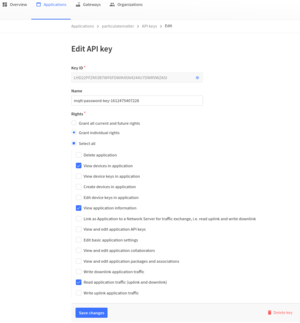Sensor-data-bridge
| Project LoraLuftdatenForwarder | |
|---|---|
| File:Nopicture.jpg | |
| LoRaWAN forwarder for particulate matter data | |
| Status | In progress |
| Contact | bertrik |
| Last Update | 2021-03-23 |
What is this
This is a Java application that sends airborne particulate matter measurement data from TheThingsNetwork and forwards it to sensor.community (formerly Luftdaten).
It is used in combination with my LoraWanDustSensor: the sensor sends measurement data to TheThingsNetwork, this application picks up the data from TheThingsNetwork and forwards it to sensor.community and to opensensemap.org.
Next steps:
- add support for NB-IOT modem with t-mobile backend, see my Sim7020 project
Requirements
You need the following:
- a server that is always on and connected to the internet, can be Linux or Windows
- a Java installation (JDK to compile), at least version 8
- some configuration on TheThingsNetwork side
- some configuration of my application (YAML file)
Compilation
To compile the software:
- clone the software from my github archive
git clone https://github.com/bertrik/LoraLuftdatenForwarder.git
- enter the LoraLuftdatenForwarder/gradle directory
cd LoraLuftdatenForwarder/gradle
- run the gradle script to build the software:
./gradlew assemble
- the application zip & tar is now available in LoraLuftdatenForwarder/LoraLuftdatenForwarder/build/distributions
To update to the latest version:
- Update software from github archive:
git pull
- perform the last two steps above again
Installation
Unzip the distribution file somewhere on your system. I put it in my home directory, for example
cd tar xvf code/LoraLuftdatenForwarder/LoraLuftdatenForwarder/build/distributions/LoraLuftdatenForwarder.tar
Configuration
Node configuration
The particulate matter measurement device needs to send data in the Cayenne format. I used the following conventions:
- PM10 is encoded as analog value on channel 1
- PM2.5 is encoded as analog value on channel 2
- PM1.0 is encoded as analog value on channel 0 (optional)
- Temperature is encoded using standard Cayenne encoding (optional)
- Humidity is encoded using standard Cayenne encoding (optional)
- Barometric pressure is encoded using standard Cayenne encoding (optional)
TheThingsNetwork application/device configuration

You need to define an 'application' on TheTheThingsNetwork.
- Go the TTN console: https://console.cloud.thethings.network/ and log in
- You need an 'application', create a new one, or use an existing one
- Within the application you need a 'device', so create a new one, or use an existing one:
- Use OTAA
- Enter the device EUI as displayed on the display
- Use the application keys as specified in my LoraWanDustSensor page
- You need an API key
- Create this on the TTN console, grant individual rights as shown in the screenshot
- NOTE: you have only one chance to copy this key somewhere, so copy/paste it locally to a text file or something
LoraLuftdatenForwarder configuration
To configure the application:
- Start the application without a configuration file, this will create a default template, stop the application again
cd LoraLuftdatenForwarder bin/LoraLuftdatenForwarder (ctrl-C)
- Edit the loraluftdatenforwarder.yaml file, example:
---
ttn:
mqtt_url_v2: "tcp://eu.thethings.network"
mqtt_url_v3: "tcp://eu1.cloud.thethings.network"
identity_server_url: "https://eu1.cloud.thethings.network"
identity_server_timeout: 20
apps:
- name: "particulatematter"
version: "V3"
key: "NNSXS......."
encoding: "CAYENNE"
luftdaten:
url: "https://api.sensor.community"
timeout: 20
opensense:
url: "https://api.opensensemap.org"
timeout: 20
ids:
"0ttn-deveui-here": "put-opensense-boxid-here"
"0004A30B001E00BE": "5eca4a0fd0545b001c0e5d46"
So:
- enter the name of your application
- enter the TTN API key you saved earlier
- other defaults are probably OK
Sensor.community
TODO
- Go to https://devices.sensor.community/ and log in
- Register a node with id 'TTN-<device-EUI-as-shown-on-display>'
- Register it with the proper configuration, e.g. SDS011 with BME280
Opensensemap
TODO
- Create a node with the proper configuration
- Copy the opensensenmap 'box id'
- Add an attribute in the TTN console:
- Go to the TTN console, General settings of the device
- Add attribute, name = 'opensense-id', value = box id that you just copied
- The boxid should be picked up automatically by the forwarder, within an hour